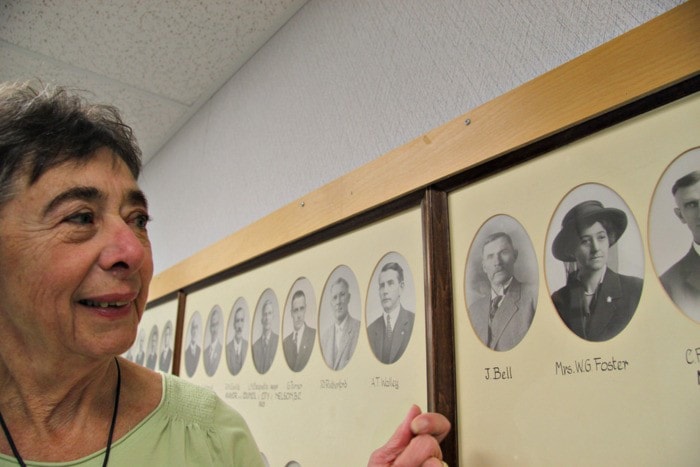For over 20 years, Frances Welwood knew only vaguely of Annie Ross Garland Foster.
When Welwood’s husband Ron took over as librarian at Nelson’s Notre Dame University in 1969, he inherited a file of correspondence between Foster — then elderly and living in White Rock — and his predecessor.
Welwood didn’t, however, pay much attention to her until 1991, when the Nelson museum created an exhibit about prominent women of the city’s past. Foster certainly fit the bill: in 1920, she was the first woman elected to city council, and two years later became the first to run for mayor. Yet these were only a few of her accomplishments.
Recognizing the name, Welwood volunteered to research Foster for the exhibit.
It was the beginning of an odyssey that culminates next Thursday at Touchstones Nelson with the launch of Passing Through Missing Pages, Welwood’s biography of Foster.
The title refers to an unpublished memoir Foster wrote when she was 63, entitled Passing Through, but later removed several pages from.
Although Welwood isn’t certain why Foster excised them, she does have some idea of their contents. It’s not giving too much away to say Annie found herself wrapped up in a sensational murder case, acting as an advocate for the accused.
DISCOVER HERSTORY
Annie grew up in New Brunswick, the eldest of three children. After graduating high school at the top of her class, she attended the University of New Brunswick and picked up a teaching certificate, but initially tried nursing.
In 1905, she headed west. However, her idiosyncratic autobiography routinely fails to name people and places, making Welwood’s job harder.
“The first place she goes is somewhere near Regina, but she never tells you where,” Welwood explains. “She spent four years at the University of New Brunswick, but not once does she name the institution. She had these peculiarities that make you very suspicious.”
Although Foster said she wrote her memoirs “so future generations may know how I felt and reacted,” Welwood points to “gaping holes” in the story.
“I was a little bit annoyed with the way she presented things, and used silly road blocks, because you knew darn well if anybody really wanted to know, like me, they could find out.”
Welwood ultimately established the Saskatchewan town where Foster taught was Mortlach.
“That was a hard one. I worked backwards from the name of a student she mentioned and used census records to narrow it down.”
Foster then moved to Rosthern, where she first encountered the Doukhobors, whom she would write about later.
She arrived in Nelson by train in August 1908, and soon met William Garland Foster, editor of the Daily News. They took meals at the same boarding house.
Annie taught at Central School and was secretary of the Nelson University Club. In 1914, she became the first woman principal of Hume School.
The outbreak of World War I hastened her marriage to Garland Foster, and their departure from Nelson, first to Vernon where her husband was in military training, then to London, where she became a Red Cross nursing sister.
Days before the armistice, Garland Foster was killed in action. To compound her grief, Annie lost the twins she was carrying. She returned to West Kootenay to teach, while becoming involved in the Great War Veterans Association.
“She was quick to realize that you didn’t just come home and say ‘Okay, war is finished. I’ll go back to being a postman,’” Welwood says. “You bring all this baggage with you. She was interested in mental disabilities and the effect of trauma.”
In the procees, she became involved in politics and was elected to Nelson council. Although she helped restore the city’s streetcar system to sound financial footing, her husband’s old newspaper was not kind to her. She did not seek re-election, although in 1922 she ran unsuccessfully for mayor.
In the next few years, her life took a shocking turn. It was this period she deleted from her autobiography, leaving a pencil notation “Six pages removed.”
“That leaves me to speculate why and at what point,” Welwood says. “Did she simply not want people to know?”
Welwood isn’t sure if she was the first person in Nelson to learn Annie’s secret, but “if I didn’t give the whole story, I’d be as guilty as she was of holding back. You don’t do it for sensation-seeking reasons. You do it because this is a real human interest story.”
That was Annie’s personal life. Professionally, she eked out a living as a writer, frequently contributing to newspapers and magazines. Her biography of Mohawk princess Pauline Johnson was the standard text for many years, and she was a charter member of the Canadian Authors Association. At 55, she also enrolled in a library sciences program at McGill University.
Welwood travelled to New Brunswick and White Rock in pursuit of Annie’s story, and about six years ago sat down to write.
“She wrote her memoirs at 63. I was writing about her memoirs when I was 63. It clicked right from the beginning, and I felt she has become a friend.”
Welwood took a year to produce the first draft, with husband Ron going through each chapter as it was completed. The manuscript then went through several revisions before Caitlin Press agreed to publish it.
Welwood showed it to local writing instructor Verna Relkoff, who “changed direction on it a bit to include me and my search. So every once in a while I come into the story.”
Next Thursday’s launch at Touchstones runs from 6:30 to 8 p.m.
